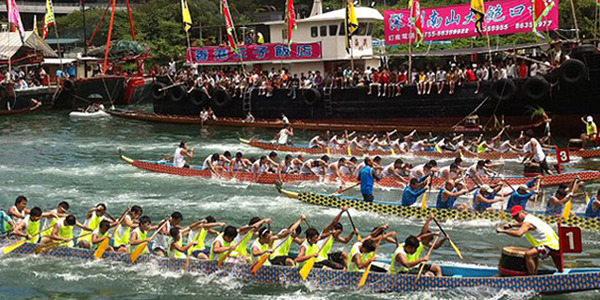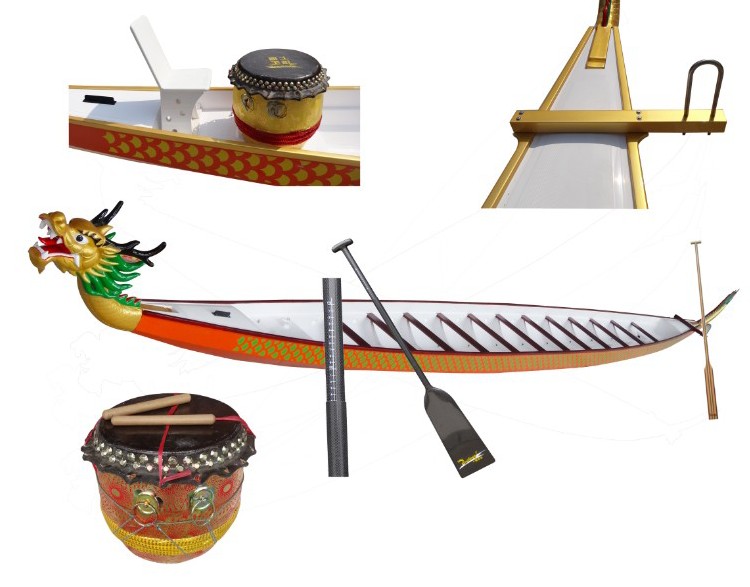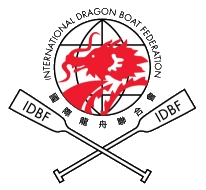A dragon boat is a human-powered watercraft originating from the Pearl River Delta region of China‘s southern Guangdong Province. These were made of teak, but in other parts of China, different kinds of wood are used. It is one of a family of traditional paddled long boats found throughout Asia, Africa, the Pacific islands, and Puerto Rico. The sport of dragon boat racing has its roots in an ancient folk ritual of contending villagers, which dates back 2000 years throughout southern China, and even further to the original games of Olympia in ancient Greece. Both dragon boat racing and the ancient Olympiad included aspects of religious observances and community celebrations, along with competition.
Dragon Boat Racing
History
Dragon boat racing is a canoe-sport and began as a modern international sport in Hong Kong in 1976. These boats are typically made of carbon fiber, fiberglass, and other lightweight materials. For competition events, dragon boats are generally rigged with decorative Chinese dragon heads and tails. At other times (such as during training), decorative regalia is usually removed, although the drum often remains aboard for drummers to practice. For races, there are 18-20 people in a standard boat, and 8-10 in a small boat, not including the steersperson (helm) and the drummer.
In December 2007, the central government of the People’s Republic of China added Duanwu, along with Qingming and Mid-Autumn festivals, to the schedule of national holidays.

Rules
For Rookie Mushers Planning to Run the 2019 (or later) Iditarod Trail Sled Dog Race
If you are a rookie musher planning on entering a future Iditarod, you must get a report card from your qualifying races completed by race officials and returned to the Iditarod office within 10 days of the end of the qualifying race. It is YOUR responsibility to advise officials prior to the start of the race that you are using that race for a qualifier and will need the report card completed and to provide officials with the correct form, which you will find on the website along with the other paperwork. That way, officials will know ahead of time to watch you so they can complete the report card. You should do that if there is any slight thought in your head about one day running the Iditarod. There is no time frame on completing qualifiers.

Equipments
The crew of a standard dragon boat is typically 22: 20 paddlers in pairs facing toward the bow of the boat, 1 drummer or caller at the bow facing toward the paddlers, and 1 steered standing at the rear of the boat. Dragon boats, however, do vary in length and the crew size changes accordingly, from small dragon boats with only 10 paddlers up to traditional boats which have upwards of 50 paddlers, plus drummer(s) and steered.
Drummer:
The pulsation of the drum beats produced by the drummer may be considered the “heartbeat” of the dragon boat. The drummer leads the paddlers throughout a race using the rhythmic drum beat to indicate the frequency and synchronicity of all the paddlers’ strokes (that is, the cadence, picking up or accelerating the pace, slowing the rate, etc.). The drummer may issue commands to the crew through a combination of hand signals and voice calls, and also generally exhorts the crew to perform at their peak. A drummer is typically mandatory during racing events, but if he or she is not present during training, it is typical for the sweep to direct the crew during a race. The drummer’s role is both tactical and ceremonial. In official competitions, such as world championships, drummers must physically beat the drum, else the team may be issued a penalty. In other events or practices, the drummer of an experienced team may not hit the drum, as the team can paddle naturally together, sans a drum beat.
Good drummers should be able to synchronize their drumming with the strokes of the leading pair of paddlers, rather than the other way around.
Paddlers
Pairs of paddlers sit facing forward in the boat, and use a specific type of paddle which, unlike equipment used in rowing, is not rigged to the boat in any way. Because the paddlers face the direction of boat-movement, dragon boaters “paddle,” and do not “row.”
The paddle now accepted by the International Dragon Boat Federation has a standardized, fixed blade surface area and distinctive shape derived from the paddle shapes characteristic of the Zhu Jiang (Pearl River) delta region of Guangdong Province, China, close to where Hong Kong is located. The IDBF[2] Paddle Specification 202a (PS202a)[3] has straight flared edges and circular arced shoulders, based geometrically on an equilateral triangle positioned between the blade face and the neck of the shaft.
The first pair of paddlers, called “pacers,” “strokes” or “timers,” set the pace for the team and are responsible for synchronizing their strokes with one another. It is critical that all paddlers are synchronized. The direction of the dragon boat while racing is set by the steerer, but for docking and other maneuvers, individual paddlers may be asked to paddle (while others either stop the boat or rest) according to the commands given by the drummer or steerer.
There are generally three different strokes used by paddlers: a (normal) forward stroke, a backstroke, and a draw stroke.
Steerer:
The direction of a dragon boat’s movement is controlled by the steerer standing in the back of the boat. Many terms exist for the person steering the boat, such as steerer, steersperson, sweep, and helm.
The steerer manipulates a long (typically 9-feet) straight oar, called a steering oar. The steering oar is situated in the upside-down U-shaped oar lock. The oar lock is housed on top of the steering arm, which sticks out perpendicularly on the back-left of a dragon boat.
The oar is used to both steer the boat as it is moving and adjust the positioning of the boat. To steer, a steerer will put the blade of the oar into the water and either push the handle away from him/her, or pull it toward him/her. Doing so will turn the boat right or left, respectively.
A steerer can also use the steering oar to adjust the position of the boat by cranking. When a steerer cranks the steering oar, the stern of the boat moves either to the left or right, spinning the boat. This is typically executed to turn the boat around at practice or to ensure a boat is lined up straight and pointing directly down a racecourse.
Association
The established International Federation for dragon boat sport is the International Dragon Boat Federation (IDBF). In 2007, the IDBF was recognized as a member of Sport Accord (the former General Association of International Sports Federations, GAISF) which is part of the Olympic Movement, considering the own historical and cultural backgrounds and identities of dragon boat sports.
IDBF member associations or federations have been established in 89 countries or territories since 1991. The IDBF is not presently an Olympic International Federation of the International Olympic Committee (IOC), but the IOC is currently considering the IDBF application for Olympic Federation status.



